Sharifzadeh ‘Are We Already Gone?’ An Analysis of Contemporary Social Diaspora
I was so excited when my lovely friend Negin Sharifzadeh let me know about her show Are We Already Gone? An artist and an animator, Negin’s curation is consistently both controversial and relatable. The exhibition, addressed themes of social diaspora and loss in lieu of the animation office’s relocation. The shift in space after 20 years provided this opportunity to examine widespread absences on a social, global scale. Extended until tomorrow, you should definitely check it out!
I planned to publish this review in ArteNews, and will definitely link if it ends up going in! In the meantime, check out the exhibition and the photos by Karen Sterling:
https://www.facebook.com/events/792874104099135/
All works are for sale, please contact us if interested and I’ll pass your info to Negin.
Social Diaspora Imagined
Earthen branches welcome at the entry to the showcase, literally rooted in transition. Negin’s own work was particularly haunting: Story of a Curse and Holding in the Sound, both mixed media with wood, had a fairytale quality, as if the viewer was walking through a forest on a path to discovery. The second half of the space evolves into expressions and articulations of self. Maiden Voyage is a curatorially linking work by Suprina Kenney, with a carved face springing from the curving branch.

All photos courtesy of Karen Sterling and Negin Sharifzadeh (This work is by Lucy Hodgson)
Another striking work was Mehran Saber’s Metamorphosis, an arguably magically realist large oil on canvas. The older couple centered in the painting has a haunting expression, seemingly overwhelmed by the animation surrounding them. This pathos is undeniably provocative for the viewer, not least with the juxtaposition of artistic styles in seamless diversity.

Identity takes the particularly powerful form of anger with Ruth A. Mora’s Ignorance and Indifference. The viewer crouches beside sheared papers of vice in a red-lit room, reading the shreds of “corruption” “racism” and violence. In a faint and monotone voice, a woman said “I don’t know. I don’t care” on repeat. The dichotomy created between repetitive indifference and literally piles of unavoidable woes feels deliberately false, ultimately powerful in its subtle suggestion of the need for change.

Not all the work is forceful, however. Ali Chitsaz’s mirrored acrylics expressed the same questions of identity even comically: First the viewer peered into a speck of mirror painted with a loose self portrait for See yourself in me, and then another abstract expressionist rendering of See yourself in John Travolta. In a way, this quick infusion of a seemingly irrelevant celebrity has elements of Warhol, whereas the strokes of Chitsaz’s painting are almost reminiscent of Max Beckmann. Although undeniably humorous, the allusion to fragmented identity is challenging.

Iranian, Palestinian, Egyptian and American artists among others expound on this theme of loss in self. In a sociopolitical atmosphere too often plagued by hate speech and misguidance, an artistic overture on disappearance, and inadvertently, belonging, is critically valuable.
What's Your Reaction?
Editor-at-Large, Cultbytes Alexandra Bregman has written for The Wall Street Journal, Architectural Digest, The Art Newspaper, and the Asian Art Newspaper among others. She began her career with internships at Christie's and Gagosian gallery 10 years ago, later traveling to India and France for work and ghostwriting for a global CEO. Bregman spent time at Université Paris IV-Sorbonne, and completed degrees at Smith College and Columbia Graduate School of Journalism. l igram |

